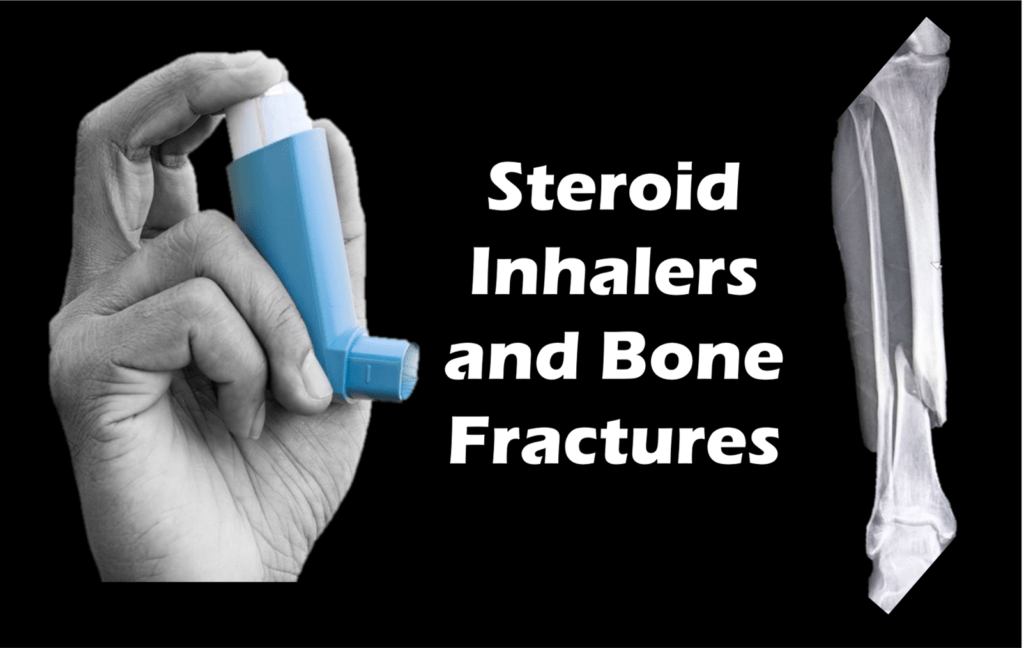More Windex: Steroid Inhalers and Bone Health

Steroid inhalers are common these days. The idea was supposed to be that by inhaling low doses of steroids, we could avoid the side effects of higher oral and intravenous steroids. Did this turn out to be true? Nope. Let’s dig in.
Steroids are Super Nasty
As I wrote yesterday, steroids are the Windex of medicine. Do you remember the father in My Big Fat Greek Wedding who would spray Windex on everything? Well, that’s how most physicians view steroids. We use them for everything from knee pain to asthma.
The problem? Steroids have been associated with all sorts of nasty side effects. For example, a bone disease where your bones turn to mush (osteonecrosis). This happens in a dose-dependent fashion (6). Meaning the more steroids you get exposed to, the more likely you are to get this awful disease.
Here are some other issues:
- Elevated blood sugar
- Increased risk of infection
- Glaucoma
- Suppression of adrenal gland hormone production
- Fluid retention
- Confusion or delirium
- High blood pressure
- Weight gain and cushingoid syndrome (bizarre fatty deposits like a moon face)
- Osteoporosis
Steroid Inhalers
334 million people worldwide are diagnosed with asthma, a condition characterized by airway constriction that makes it hard to breathe. Steroids can reduce inflammation which can open the airways. Hence, they have become a mainstay of asthma treatment.
When steroid inhalers made their debut a few decades ago, the idea was simple. Reduce the dose of steroids and make it easy for the patient to conveniently inhale every day with a small device that they can carry. This will reduce the need for higher dose steroids that we know can cause severe side effects and patients will be safer. However, research now shows that this was wishful thinking.
New Research
By examining data from anonymized health records, researchers who authored an October 2020 study published in the journal Thorax concluded that patients on steroids for asthma had higher rates of osteoporosis and fractures than those who didn’t use steroids. And the higher the cumulative dose and the longer they were on the medication, the greater the risk.
Individuals who were given 9 or more prescriptions for steroid pills in a year were at the greatest risk of osteoporosis — more than 4 times more likely to develop the degenerative bone disease. They were also at higher risk for fragility fractures, even after accounting for influencing factors like smoking, weight, and alcohol intake. The most surprising thing in the study was that the risk for fractures and osteoporosis was elevated by about 60% for steroid inhalers. That’s not supposed to happen.
What We Know
Several previous studies — including one from September 2010, have linked corticosteroid use and osteonecrosis, a degenerative disease that results from fewer stem cells and the eventual collapse of the bone (2). Even short-term use has been associated with an increased risk of fractures, blood clots and sepsis, according to an April 2017 study in BMJ (3).
But there’s also some potentially promising evidence that vitamin E supplementation may prevent steroid-induced osteonecrosis, according to a February 2010 study (4). And an August 2014 study suggests that curcumin’s anti-inflammatory properties may help alleviate some asthma symptoms when used in conjunction with corticosteroids (5). This could lessen the number of inhaler prescriptions required.
The upshot? Patients who use steroid inhalers are at risk for bone diseases. That’s a fact that would likely surprise most physicians who write these scripts. So like everything else in healthcare, buyer beware!
[PLEASE NOTE: DO NOT STOP ANY PRESCRIPTION FROM A PHYSICIAN INCLUDING A STEROID INHALER WITHOUT FIRST DISCUSSING WITH THIS YOUR DOCTOR!]
______________________________________________
Related
>> Can Supplements Help with Asthma?
References
1. Chalitsios CV, Shaw DE, McKeever TM. Risk of osteoporosis and fragility fractures in asthma due to oral and inhaled corticosteroids: two population-based nested case-control studies. Thorax. 2020 Oct 21:thoraxjnl-2020-215664. doi: 10.1136/thoraxjnl-2020-215664. Epub ahead of print. PMID: 33087546.
2. Powell C, Chang C, Naguwa SM, Cheema G, Gershwin ME. Steroid induced osteonecrosis: An analysis of steroid dosing risk. Autoimmun Rev. 2010 Sep;9(11):721-43. doi: 10.1016/j.autrev.2010.06.007. Epub 2010 Jul 9. PMID: 20621176.
3. Waljee AK, Rogers MA, Lin P, Singal AG, Stein JD, Marks RM, Ayanian JZ, Nallamothu BK. Short term use of oral corticosteroids and related harms among adults in the United States: population based cohort study. BMJ. 2017 Apr 12;357:j1415. doi: 10.1136/bmj.j1415. PMID: 28404617.
4. Kuribayashi M, Fujioka M, Takahashi KA, Arai Y, Ishida M, Goto T, Kubo T. Vitamin E prevents steroid-induced osteonecrosis in rabbits. Acta Orthop. 2010 Feb;81(1):154-60. doi: 10.3109/17453671003587101. Erratum in: Acta Orthop. 2010 Oct; 81(5):647. PMID: 20146637.
5. Abidi A, Gupta S, Agarwal M, Bhalla HL, Saluja M. Evaluation of Efficacy of Curcumin as an Add-on therapy in Patients of Bronchial Asthma. J Clin Diagn Res. 2014 Aug;8(8):HC19-24. doi: 10.7860/JCDR/2014/9273.4705. Epub 2014 Aug 20. PMID: 25302215.
(6) Yao TC, Huang YW, Chang SM, Tsai SY, Wu AC, Tsai HJ. Association Between Oral Corticosteroid Bursts and Severe Adverse Events: A Nationwide Population-Based Cohort Study [published online ahead of print, 2020 Jul 7]. Ann Intern Med. 2020;10.7326/M20-0432. doi:10.7326/M20-0432

NOTE: This blog post provides general information to help the reader better understand regenerative medicine, musculoskeletal health, and related subjects. All content provided in this blog, website, or any linked materials, including text, graphics, images, patient profiles, outcomes, and information, are not intended and should not be considered or used as a substitute for medical advice, diagnosis, or treatment. Please always consult with a professional and certified healthcare provider to discuss if a treatment is right for you.
